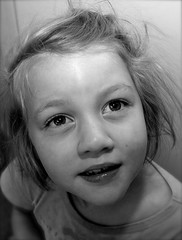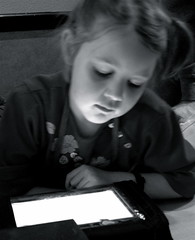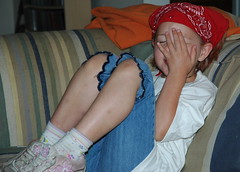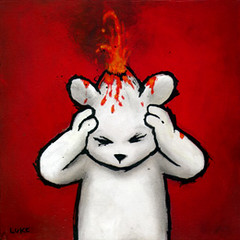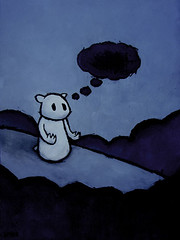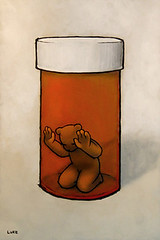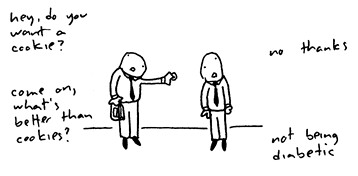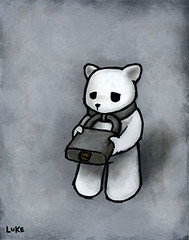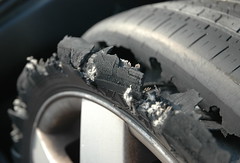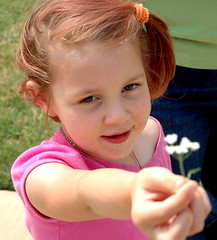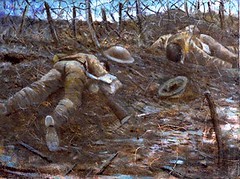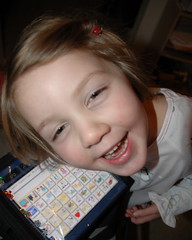Julie sent me a link yesterday, to a site about a little three year-old girl in Connecticut named
Faith Autumn Tremblay who suffers from a rare brain disorder called
Periventricular Heterotopia. Julie heard about Faith from one of her friends back home in Connecticut whose company has partnered to help this family and who actually got to meet and spend time with her.
The story sounds familiar, with lots of testing and worrying and trying to identify a rare brain disorder. But it wasn't until I followed some of the links to learn more about
Periventricular Heterotopia that I realized just how much she has in common with Schuyler. I recognized the name of the
Christopher A. Walsh Laboratory in Boston as soon as I saw it.
Dr. Walsh is one of the doctors who, along with Dr. William Dobyns (the doctor in Chicago that we went to see last year), is a co-investigator in the
Polymicrogyria Research Collaboration. It's an NIH-sponsored project to study the probable genetic causes of
polymicrogyria (PMG), the group of disorders that includes
Cogenital Bilateral Perisylvian Syndrome. The three of us provided DNA samples for this project while we were in Chicago. We are all about the science.
At this point, my interest in Faith's story became more immediate. In a very real sense, she's family. Faith's monster and Schuyler's monster are kissing cousins, after all. I went to do some reading on
Periventricular Heterotopia, which like CBPS is an abnormality that occurs in the brain as it develops during pregnancy. It can even develop in association with other abnormalities like polymicrogyria.
Aside from some learning disabilities, it looks like patients with
Periventricular Heterotopia don't usually suffer from other neurological disorders like Schuyler does. But the thing that they DO face is the thing that is probably still lurking in Schuyler's future.
Seizures. And bad ones. In Faith's case, they are extreme and life-threatening. The site doesn't make this clear, but this little girl has already flat-lined from her seizures on at least one occasion. She has my deepest sympathies, because her present life and struggle taps into my worst fears for Schuyler's future.
There's been a lot of talk about fear around here lately. And I'll admit, the anonymous threat that was posted here gave me pause. So did something else, something I didn't mention because I didn't want to tell Julie about it immediately. I finally told her tonight, and so now I can mention it here. A few hours after that threat was posted, I received a phone call at work, from what sounded like a woman trying to sound like a man. It was supposed to sound scary, and perhaps it would have if not for one tiny detail.
"See how easy it was to find you? It'll be just as easy to find SHOOLER."If you're trying to be menacing, you might start by getting your target's name right.
I'm not afraid of anonymous callers or the Jane Book Club or anyone else capable of using Google or directory assistance.
I'm afraid of seizures.
I'm afraid of the monster that kills some kids with CBPS, because that's the thing, along with choking and breathing issues, that does it. Their parents have written to me, they've sent the most heartbreaking emails you can possibly imagine. Not many kids with seizures die from them, but if you're a parent, ask yourself how comforting that would be. I remember when Dr. Dobyns told us that only a few of his PMG patients have died from their seizures. That's great, Dr. Sunny Side. Thanks.
Schuyler does not suffer from seizures. She has problems with fine motor control, both in her hands and in her mouth, and some mild swallowing issues that she compensates for with a lot of success. She suffers from a very significant developmental delay, but it is unclear whether that is a result of some cognitive defect or her communication issues. And those issues are extreme; she can't speak, and she hasn't developed verbally in any significant way in probably three years. She is (and almost certainly will always be) mute, and Dr. Dobyns said she would be a clumsy girl for the rest of her life, but she doesn't have seizures.
Not yet. But two facts loom over her like the Sword of Damocles. The first fact: Dr. Dobyns estimated her chances of developing seizures at over 80%, probably between the ages of six and ten. The second fact: based on his examination of her MRI, Dobyns estimated that between sixty and seventy-five percent of Schuyler's brain is profoundly malformed. When he met Schuyler for the first time, he was surprised to see that not only was she not confined to a wheelchair, but was completely ambulatory and not visibly impaired in her physical development. In my book, I quote him:
"Now, this just illustrates exactly how little we still know about the human brain. From examining this MRI, I can tell you that I certainly didn't expect to walk in the room and find a little girl running around and playing like a neurotypical child. I wouldn't expect Schuyler to be functioning at a significant level mentally or physically, but there she is. She looks and behaves like any other kiddo, and she's obviously functioning cognitively at a reasonable level. Those affected areas of her brain are working, they’re doing something. We just have no idea how, or what her brain is capable of."So when you wonder what we're afraid of, that's simple. We're not afraid of internet bullies hiding behind anonymity and private forums. We're afraid of Schuyler's mysterious, medically inexplicable brain and what it has in store for her. We're not afraid of someone stalking Schuyler because in a very real way, she is already being stalked.
We're afraid of Schuyler's monster.
